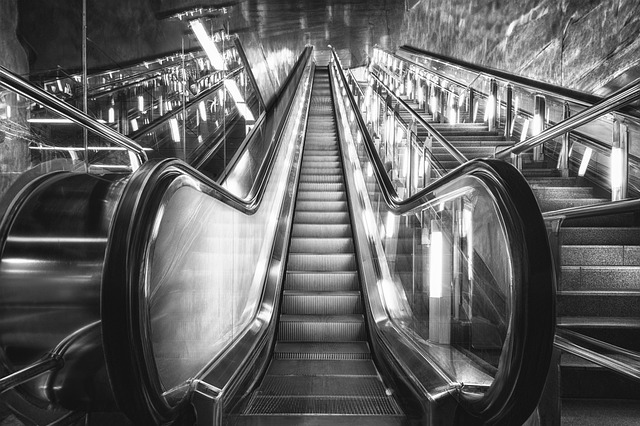Escalators are a routine part of modern life—found in shopping malls, airports, office buildings, and transit hubs. Although a stopped escalator may appear similar to a staircase, it is not a safe or legally appropriate means of ingress or egress. Property owners, facility managers, and maintenance personnel have a duty to ensure that escalators are used only in accordance with their intended design and functionality. Allowing—or failing to prevent—people from walking on a non-operational escalator introduces serious safety hazards.
THE HIDDEN REASONS TO AVOID USING A STOPPED ESCALATOR
1. Escalators Are Not Designed to Be Stairs
When escalators stop working, they do not become legal or functional substitutes for stairs. Building codes and safety standards recognize that stairways must meet specific dimensional requirements and slip resistance standards to be considered safe for walking traffic. Escalators do not meet these criteria.
2. Non-Uniform Step Dimensions
One of the most significant dangers lies in the non-standard rise and tread of escalator steps:
– Standard stairs: Typically have a 7-inch rise and 11-inch tread
– Escalator steps: Commonly have an 8-inch rise and a 16-inch tread
This variation can disrupt a person’s natural walking rhythm, increasing the risk of trips and falls, especially for older adults or individuals with mobility issues. The larger, inconsistent step dimensions also violate conventional building codes that prioritize uniformity for safe pedestrian use.
3. Ambient Lighting Issues
Escalators are often located in indoor or underground environments with controlled or low ambient lighting. When an escalator is in motion, internal lighting and movement cues help orient users. But when it stops, poor lighting can contribute to visual disorientation and missed steps, especially if the area was not designed for pedestrian traffic.
4. The “Wallpaper Effect” and Visual Confusion
Escalator steps are marked by repetitive vertical tread lines—a design that, while functional in motion, can become hazardous when the escalator is stationary. This creates what’s known as the “wallpaper effect,” where the uniformity of visual patterns can lead to:
– Spatial disorientation
– Difficulty judging depth
– Missteps or stumbles due to visual confusion
This effect is especially dangerous for individuals with visual impairments or depth perception issues.
LEGAL IMPLICATIONS FOR PROPERTY OWNERS
Allowing public access to a stopped escalator—or failing to barricade it and post clear warning signage—can constitute a breach of duty under premises liability law or negligence. Under standards like ASME A17.1-2004, Section 8.6.10.5, if an escalator is not in safe operational condition, it must be:
- Taken out of service
- Barricaded at both landings
- Accompanied by notice to the responsible party
Failure to comply with these requirements may support a negligence per se claim if someone is injured.
What is Negligence Per Se
Negligence per se occurs when a person or entity violates a statute or regulation designed to protect public safety, and that violation causes the kind of harm the law was intended to prevent. In Missouri, escalator safety is governed by a combination of state regulations, national engineering standards, and local building codes. Violating these standards may automatically establish a presumption of negligence.
KEY SAFETY REGULATIONS
1. 11 CSR 40-5.010 – 40-5.150
These Missouri Code of State Regulations govern the design, construction, maintenance, and repair of escalators and elevators. Under these rules, all escalators must comply with the ASME A17.1 Elevator and Escalator Safety Code, which represents the national engineering standard.
2. ASME A17.1-2004 – Section 8.6 (with 2005 Addenda)
This safety code is considered the minimum compliance standard for escalator maintenance and operation. It requires:
– Daily safety checks for any equipment operating 24 hours a day.
– If unsafe conditions are found, the escalator must be immediately taken out of service, landing areas barricaded, and the responsible party notified.
– Maintenance, repair, and replacement must meet the standards of Section 8.6.
– Failure to meet these requirements can constitute a violation of law, potentially establishing negligence per se in a civil lawsuit.
3. Lighting Requirements
ASME A17.1 also mandates that escalators must be properly lit with at least 5 foot-candles (50 lux) of illumination. Insufficient lighting can contribute to trip-and-fall hazards. If poor lighting contributed to your injury, a lighting test can determine compliance.
4. International Building Code (IBC) and Local Adoption
The IBC, adopted by many municipalities, reinforces these safety standards. Chapter 34.01.2 emphasizes a property owner’s responsibility to maintain safe premises—including the maintenance of escalators. By incorporating ASME A17.1 by reference, the IBC gives legal weight to these engineering standards. Failure to comply with these maintenance provisions can further support a negligence per se argument.
COMMON ESCALATOR INJURIES
Escalator-related injuries often include:
- Lacerations or amputations due to entrapment
These injuries can be catastrophic and may result in permanent disability or death.
What Should You Do After an Escalator Injury?
- Seek medical attention immediately.
- Report the incident to the property owner or facility operator.
- Document the scene (if possible)—photos, witness contact information, and escalator number or location.
- Contact an experienced personal injury attorney as soon as possible to investigate potential violations of safety codes.
Let Us Help
At MHM Legal, our attorneys understand the complex legal and technical standards involved in escalator safety. We work with engineers, safety experts, and investigators to uncover violations of state and national codes—including those that support negligence per se claims.
If you or a loved one has been injured in an escalator accident, contact us today for a free consultation at 314-725-5050. You may be entitled to compensation for medical bills, lost wages, and pain and suffering.
